John Hurrell – 4 February, 2016
Enberg has an aptitude for digging out obscure slices of information that (against all odds) overlap and bind on to a central thematic core. He presents a kind of historic narrative via a suite of complex interwoven attendent themes - like a set of multiple (very interesting) footnotes that tangentially elucidate an invisible essay that is nevertheless present - and which you have to figure out and ‘read' yourself.
Auckland
Oscar Enberg
the prophet, the wise, the technician and the Pharisee
Curated by Henry Davidson
11 December 2015 - 12 February 2016
As part of the New Horizons season at Artspace, Oscar Enberg presents a typically multiple-layered, intertextual installation of sculpture that shrewdly references historic and cultural sources widely scattered in origin. These include: the nativity story, the history of big department stores in New Zealand’s main cities, the late Giovanni Intra, and the activity of benefactors in our consumerist community. Enberg has an aptitude for digging out obscure slices of information that (against all odds) overlap and bind on to a central thematic core. He presents a kind of historic narrative via a suite of complex interwoven attendent themes - like a set of multiple (very interesting) footnotes that tangentially elucidate an invisible essay that is nevertheless present - and which you have to figure out and ‘read’ yourself.
In a spiralling decentred layout in the large square Artspace gallery, various components are positioned and made available for conceptual interaction and possibly ambiguous interpretation. The leading protagonists are a wicker ‘manger’/pram that represents the charitable values of the baby Jesus - it could also be a picnic hamper; the Auckland department store owners, John Court (1846-1933) and his brother George, with John being a generous philanthropist within the Auckland community; Intra the Teststrip artist, who apparently was descended from John; Ballantynes department store in Christchurch, from which a mechanically gesturing nativity ‘wise man’ was borrowed; a painted image of a beggar as originally incorporated in Neapolitan nativity scenes; and Jamuna the Indian elephant that John Court acquired for Auckland Zoo in 1923.
As a method of organisation Enberg tends to like to arrange his material in physical clusters, so that the different conceptual referents are encountered in bundles: a sort of self conscious clumping where assorted images and custom-made items are kept in close proximity to form freestanding sculptural units.
The show plays on multiple (sometimes opposing) interpretations that flip back and forth, often to reinforce the ‘spirit of Christmas’ and generosity towards the needy, but then very discreetly to also question the motivations. The immaculately conceived, pregnant, male mannequin in Intra’s punk suit could also be a glutton with a paunch. Behind him is a table for eating Christmas dinner from, raised high on added white legs to be out of reach the rest of the year. Tied on to a table leg is a bundle of willow twigs for beating back those who try to clamber up. Those canes also could be set aside for weaving another manger/hamper next year.
A takeaway publication presenting a richly informative essay by Henry Davidson comes bracketed within what seem to be the pages (with added swastika) of John Court’s store guide for the Direct Supply Company (DSC) building in Queen St, where Farmers are now located. Narrow trays of rotting fruit with a turkey, or an eviscerated peacock (a reference to fashion?) lie on the floor, alongside ball and chains that suggest over-indulgence is addictive or - flipping it over - that penury is hard to get free of.
There is also a correlation between the display rooms of department stores and dealer galleries. The Ballantyne’s ‘wise man’ doubles as a beggar, like the painted mendicant with bowl on the other side of the room. He could be a shop assistant or dealer now on hard times. The elephant’s metal trunk on the main wall seems to represent Court’s generosity to his fellow citizens, but could also be a hoover for cynically sucking up financial resources by proffering luxury goods to those who can’t afford them, or a chimney for the smoke of burnt up money. The desiccated Indian flowers on a line of circular wreaths near the entrance allude to the transience of beauty, the competitiveness of both the Olympics and the capitalist ethos, as well as to Lotto and the monetary fantasies that sustain it. Wrought iron pokers leaning on the ‘manger’ could be weapons of immanent violence or tools for stoking up the fires of Christmas commerce.
Obviously, as possibly you can tell from my comments, I think there is a lot of calculated irony in this show. The swastika added to the brochure is meant to be unsettling, while titles like The donkey who shits money, The site assigned for crime and deception (studded suit), His generous gifts, or The historical gesture to me have got tongue-in-cheek overtones or are openly provocative. You might think I’m quite excessive to be so ‘negative’ in my interpretation, and that the project is really a paean to the philanthropy of John Court. However I don’t think these are wholesome or praising images at all. They are superbly devious with an edge. The show is only up for a few more days, so if you live in Auckland come by and see for yourself.
John Hurrell
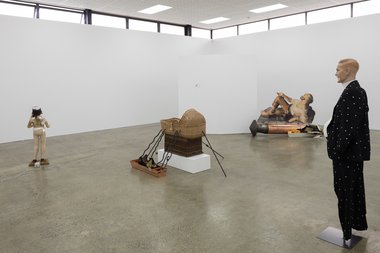
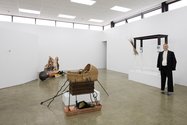
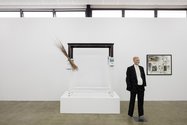
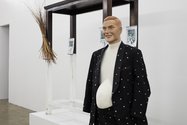

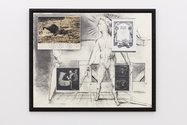
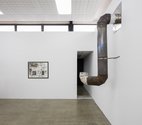
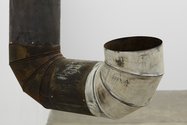
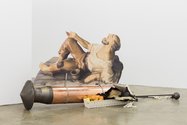
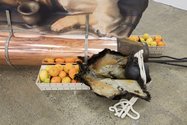
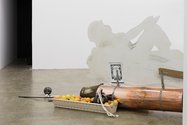
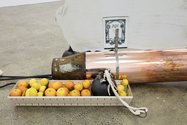
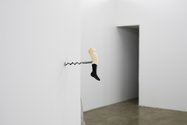


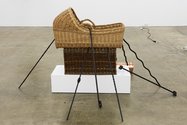
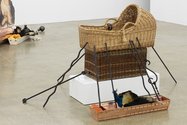
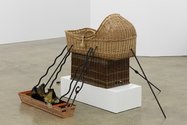
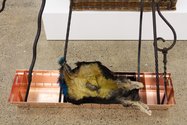
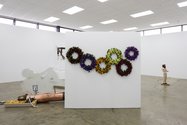

 Advertising in this column
Advertising in this column Two Rooms presents a program of residencies and projects
Two Rooms presents a program of residencies and projects



This Discussion has 0 comments.
Comment
Participate
Register to Participate.
Sign in
Sign in to an existing account.